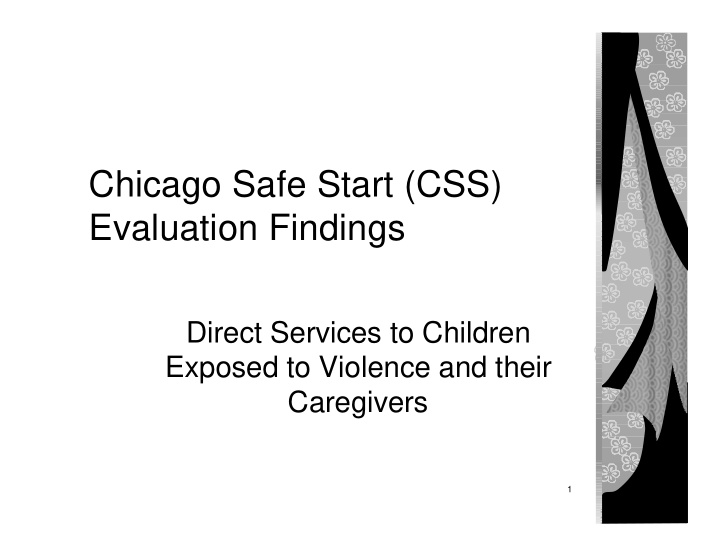



Chicago Safe Start (CSS) Evaluation Findings Direct Services to Children Exposed to Violence and their Caregivers 1
Intervention Overview CSS collaborated with a state-level violence prevention agency to expand evaluation of direct services beyond the three CSS-specific providers. Beginning in July 2004, 9 agencies provided direct services to children exposed to violence and their caregivers. Service provision is ongoing. 2
Service Provision Overview – Process Outcomes Services have thus far been provided to 196 caregivers and 140 children. Caregivers attended an average of 8 sessions; children attended an average of 4 sessions. Most services were provided in agency offices, although some were provided in homes, schools, and other community locations. 3
Service Provision Overview – Intervention Outcome Measures Service Providers Provider Information Form (e.g., therapist education, licensure and experience) Caregivers and Children Symptoms of Childhood Exposure to Violence Pre-Intervention Screening Checklist Completion of Services Forms Location of service provision Description of service type (e.g., case management, individual therapy, education) Description of service content (e.g., identifying feelings, safety planning, child development) Therapist ratings of outcomes 4
Characteristics of Children Average age = 33 months 50% female; 50% male 100% African American 62% exposed to domestic violence 46% exposed to community violence 76% experienced repeated exposure 5
Most Common Pre-Treatment Symptoms of Exposure 41% very protective of family members 38% highly aggressive, anxious or distractible 28% cries often-very emotional, mood swings 6
Type of Services Provided Caregiver Family support services Parenting education Individual therapy Child Family therapy Information and referral Group therapy 7
Content of Services Provided Caregiver Effects of exposure to violence on children Community and domestic violence Appropriate discipline Child development Child Identifying/expressing feelings Parent-child communication skills Anger management skills Symptoms reduction 8
Caregiver Outcomes Overall, caregivers showed small but significant improvements Most improved: Knowledge of children’s exposure to violence Overall family functioning Understanding of child’s developmentally appropriate behavior Ability to take care of their own mental health needs following exposure to violence Parenting skills Least improved: Environmental stability Supportive relationships 9
Child Outcomes Overall, children showed small but significant improvements Most improved: Ability to identify feelings Overall symptoms Pro-social skills Anger/aggression Least Improved: PTSD symptoms Exposure to violence after treatment began 66% - no new exposure 24% - at least one incident of new exposure 10% - additional exposure unknown (generally due to premature termination from treatment) 10
Predicting Positive Outcomes For both caregivers and children, number of sessions is positively correlated with positive outcomes. Future analyses will examine associations among outcomes and: Service type Service content Therapist characteristics (e.g., years of experience) 11
Implications for Research and Practice Collaborative design of outcome measures is critical to ensure consistent usage by diverse service providers. Caregivers and children need multiple sessions to realize the benefits of direct services. Individualized direct services appear beneficial in reducing exposure, improving family functioning, and reducing behavioral problems among exposed children. Future research should determine the most effective mix of service length, type and content. For more information or a copy of this presentation, contact Paul Schewe at schewepa@uic.edu. 12
Recommend
More recommend